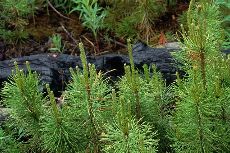One of the joys of living on the far-flung western edge of the Chilcotin Cariboo is the constant stream of reminders the changing seasons bring - reminders that we are just one part of a large, complex system that is constantly evolving, life and death intimately entwined on the miracle of Earth.
Driven by sheer force of the sun, spring breaks free from winter's icy embrace, melting snows driving the boisterous river to burst its frozen bonds. Warm sweet winds fill the air with fir perfume and redwings return to beckon the lazy hazy days of summer with their quicksilver song.
Now it is fall time. The leaves along the highway are a brilliant yellow, backlit by the morning sun, exploding into your eyes like mercury lights in a stage production.
Alas, all is not beauty and warm sensuality when the harbingers of the changing seasons come calling.
Like the rest of us, the Chilcotin critters need a place to spend the winter. And what better place than a dry, well stocked nest that is also centrally heated? Maybe it is a roof ever so humble or a wall with its nice pink fluffy quilts or, even better, a pantry full of all those great goodies. Nuts, seeds, flour, raisins, dates, a cornucopia that never ends.
All these denizens have to do is to figure out a way to get inside these great winter digs.
Mice are the sneaky ones. They can crawl through the tiniest holes, wriggle into the smallest crevices. There is even one species of Chilcotin mouse that has a communicator for asking the mother ship to "Beam me in, Scotty".
Packrats are not nearly so subtle. They are a straight ahead bunch. Kick the door in if they can. Noisy, bump thump all night long, these masters of demolition never give up.
The have been known to chew through one inch fir roofing boards, through 90 pound roll roofing, make tunnels straight up through the wall to the upper plate, find a way into the attic and then to chew down into the room below.
Packrats have an amazing understanding of spatial dimensions. How else can you explain one now famous packrat that chewed into the gable end of the house, went across the roof up and over the rafters, went down the inside the wall on the opposite gable, under the house, up into the floor, then over six feet to then chew up through the floor and, Voila!, hit the middle of the pantry? NASA has nothing on a Chilcotin packrat.
Aside from their unique perfume and their destructive tendencies, packrats are very good looking, cream and buff coloured with sharp eyes and well formed muffs for tails. They are very polite, making sure that they trade for everything they take. Spoons for eyeglasses or hay for raisins, they are very fastidious about this, much more so than most humans are.
In spite of their politeness in matters of trading, the pack rat must go. So, in the end, the packrat meets its nemesis, the Chilcotin resident. Trap in hand, a trusty length of stove pipe over his shoulder and peanut butter/raisin bait in his pocket the scene is set. Not to be outdone, Packrat steals the bait and begins its usual three a.m. shopping spree in the pantry.
Time to bring in reinforcement known as the Chilcotin feline, best little killer in the west. A few minutes in the pantry, scrabble! squeal! and the rat is caught. Not dead, caught. As everyone knows, the Chilcotin feline doesn't kill, not right away. So with thick leather gloves complete with gauntlets, (the Chilcotin resident has done this before) the game of "catch the cat before the cat drops the packrat so it can run under the piano" is underway.
This time it is resident 1, packrat 0. When the cat drops the rat, the resident quickly swoops up the dazed rat, takes it outside and uses a fire brick to crush its skull on the porch railing. Nasty, brutish and short, to quote an infamous judge.
And so it goes, the changing seasons shared the world over by mice, packrats and men.
 "The long-awaited reprinting of Diary of a Wilderness Dweller is finally taking place. This book was a national best-seller when it was first issued, but the publisher of the time phased out his adult books.
"The long-awaited reprinting of Diary of a Wilderness Dweller is finally taking place. This book was a national best-seller when it was first issued, but the publisher of the time phased out his adult books.
